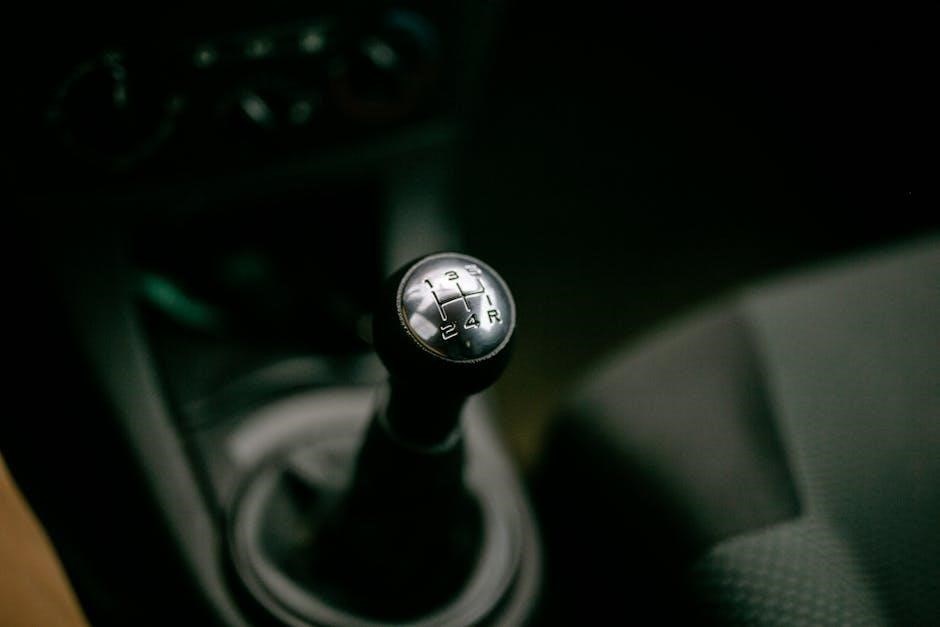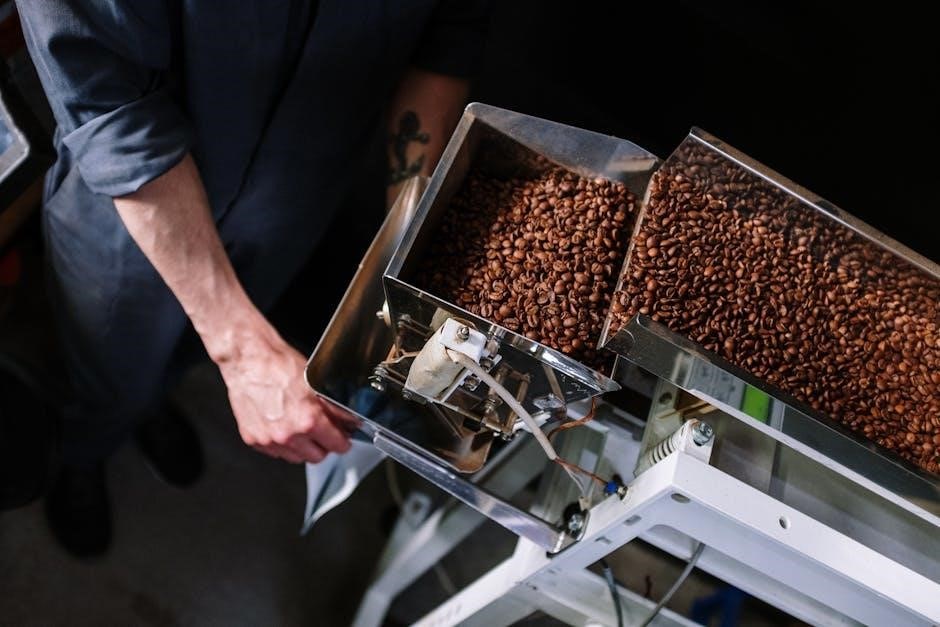
A manual boost controller regulates turbocharger boost pressure, enhancing engine performance. It works with an external wastegate to control pressure effectively, as shown in detailed diagrams.
1.1 What is a Manual Boost Controller?
A manual boost controller is a device used to regulate the boost pressure in a turbocharged engine. It allows drivers to manually adjust and control the pressure delivered by the turbocharger, providing precise control over engine performance. Typically connected to an external wastegate, the controller ensures accurate pressure management by redirecting excess exhaust gases away from the turbine. This system is essential for maintaining optimal boost levels, preventing over-boosting, and enhancing engine efficiency. The controller is a mechanical or pneumatic component that works in conjunction with the wastegate to deliver consistent and reliable performance, making it a popular choice among enthusiasts and racers seeking improved power delivery.
1.2 Purpose of a Manual Boost Controller
The primary purpose of a manual boost controller is to allow drivers to precisely adjust the boost pressure delivered by the turbocharger. By controlling the flow of exhaust gases through the external wastegate, it ensures optimal pressure levels are maintained. This prevents over-boosting, which can damage engine components, while also enabling increased power output when desired. The controller provides a mechanical or pneumatic means to regulate boost pressure, offering improved engine responsiveness and performance. It is particularly beneficial for drivers seeking to fine-tune their engine’s behavior under varying driving conditions, ensuring reliability and peak performance.

Components of a Manual Boost Controller
A manual boost controller consists of an actuator, spring, controller unit, and pressure sources. These components work together to regulate boost pressure effectively.
2.1 Actuator and Spring
The actuator and spring are essential components of a manual boost controller. The actuator responds to pressure changes, controlling the wastegate’s position. The spring provides the necessary force to keep the wastegate closed, ensuring proper boost levels.
The controller unit is the brain of the manual boost system, regulating pressure through precise adjustments. It connects to the actuator and wastegate, ensuring accurate boost delivery. Diagrams show its role in managing turbo pressure for optimal performance. Pressure sources and sensors are critical components in a manual boost controller system. These elements ensure accurate measurement and regulation of boost pressure. The pressure source typically connects to the turbocharger or intake manifold, providing the necessary input for the controller. Sensors monitor the pressure levels, delivering real-time data to the controller unit. Proper installation, as shown in diagrams, ensures seamless communication between components. The external wastegate relies on these signals to function correctly, opening or closing based on pressure readings. This setup allows for precise control over boost levels, preventing over-boosting and maintaining optimal engine performance. Regular maintenance of these sensors is essential for consistent and reliable operation. The external wastegate is a valve that diverts exhaust gases away from the turbocharger turbine to regulate boost pressure. It operates independently of the turbocharger housing. The external wastegate functions by diverting a portion of the exhaust gases away from the turbocharger turbine, controlling the rotational speed of the turbine. This regulation is crucial for maintaining optimal boost pressure levels. By bypassing some exhaust gases, the wastegate prevents the turbocharger from over-spinning, which could lead to excessive boost pressure and potential engine damage. The external wastegate is typically connected to a manual boost controller, which provides precise control over when and how much exhaust gas is diverted. This setup allows drivers to adjust boost levels according to driving conditions, ensuring improved engine performance and responsiveness. Proper installation and setup of the external wastegate are essential for ensuring reliable operation and maximizing the benefits of the manual boost control system. An external wastegate differs from an internal wastegate by its independent operation outside the turbocharger. Unlike the internal wastegate, which is built into the turbine housing, the external wastegate is a separate component. This design allows for better control over boost pressure and reduces turbo lag, making it ideal for high-performance applications. External wastegates are commonly used with manual boost controllers, as they provide more precise adjustment of boost levels. Additionally, they are easier to install and configure compared to internal systems, offering greater flexibility for tuning and customization. This separation also helps in managing higher boost pressures more effectively, making external wastegates a preferred choice for enthusiasts and racers seeking optimal engine performance. A manual boost controller regulates boost pressure by controlling the wastegate actuator. It adjusts pressure via a controller unit, ensuring precise management of turbocharger output for optimal performance. The pressure regulation process involves directing pressurized air from the turbocharger into the controller unit. This unit adjusts airflow based on user settings, ensuring precise boost levels. Sensors monitor pressure, providing feedback to maintain stability. The actuator is a critical component connected to the wastegate, converting pressure signals from the manual boost controller into mechanical movement. It responds to pressure changes by adjusting the wastegate’s position, controlling the flow of exhaust gases past the turbine. This precise modulation ensures the turbocharger operates within the desired boost range. The actuator’s responsiveness is key to maintaining consistent boost levels, especially during dynamic driving conditions. Proper installation and calibration ensure smooth operation, while diagrams often illustrate its connection to the wastegate and pressure sources. The actuator’s performance directly impacts engine efficiency and power delivery, making it essential for optimal turbocharger function. Regular maintenance is recommended to prevent malfunctions. Boost pressure management is crucial for maintaining optimal turbocharger performance. The manual boost controller works in conjunction with the external wastegate to regulate pressure, preventing over-boosting. By adjusting the controller, drivers can set desired boost levels, ensuring consistent power delivery. The actuator responds to pressure signals, modulating the wastegate to either vent excess gases or maintain boost. Proper management prevents engine damage from excessive pressure while maximizing efficiency. Diagrams often illustrate how the controller and wastegate interact to achieve precise control. This system ensures adaptability to varying driving conditions, enhancing both performance and reliability. Proper installation and calibration are essential to avoid issues like boost leaks or inconsistent pressure. Install by connecting the pressure source to the controller inlet and routing the outlet to the wastegate. Refer to diagrams for precise port connections and setup instructions. Before installing a manual boost controller, ensure the engine is cool to prevent damage. Disconnect the battery to avoid electrical hazards. Gather tools like wrenches, Teflon tape, and vacuum hoses. Consult the diagram for port connections. Inspect hoses for cracks or damage. Ensure the wastegate is functioning properly. Verify all components are included in the kit. Clean the area around the turbo and wastegate for a secure installation. Familiarize yourself with the controller’s operation. Plan the routing of hoses to avoid interference with moving parts. Ensure proper ventilation in the workspace. Double-check all connections before starting the engine. Follow the manufacturer’s guidelines for torque specifications and safety precautions. For internal wastegate setup, locate the factory boost control solenoid by following the hose from the turbocharger actuator. Disconnect the hoses from the solenoid and reconnect them to the manual boost controller. Ensure the connections are secure and use Teflon tape for a leak-free seal. Refer to the diagram for proper port alignment. Route the hoses away from moving components to prevent damage. Double-check the wastegate actuator’s operation to ensure it responds to boost pressure changes. Test the system at low RPM to confirm proper function before increasing boost levels. Avoid over-tightening connections to prevent damage to the controller or wastegate. Follow the manufacturer’s torque specifications for all connections. Proper setup ensures accurate boost control and optimal engine performance. For external wastegate setup, begin by allowing the engine to cool. Locate the bottom port on the external wastegate and the pressure source port, as shown in the diagram. Install the boost tee in the wastegate pressure line, ensuring proper alignment. Connect the pressure source from the turbocharger to the inlet of the manual boost controller. Route the outlet of the controller to the wastegate actuator, keeping hoses away from heat sources and moving components. Secure all connections with Teflon tape to prevent leaks. Refer to the manufacturer’s instructions for specific torque values. Test the system at low RPM to verify proper operation before increasing boost levels. Ensure the wastegate opens smoothly to maintain accurate boost control. Proper setup ensures optimal engine performance and prevents damage to turbo components. Connecting pressure sources involves linking the turbocharger’s pressure output to the manual boost controller and external wastegate. Start by identifying the bottom port on the external wastegate and the corresponding pressure source port, as indicated in the diagram. Install a boost tee in the wastegate pressure line to facilitate multiple connections. Next, attach the pressure source hose from the turbocharger to the inlet of the manual boost controller. Ensure this connection is secure to prevent leaks. Then, connect the outlet of the controller to one of the bottom air ports on the wastegate. Use Teflon tape on all threaded connections for added sealing. Finally, test the system at low RPM to verify proper operation before increasing boost levels. This setup ensures precise control over boost pressure, enhancing engine performance and preventing damage to turbo components. Diagrams provide a clear visual representation of manual boost controller and external wastegate connections, simplifying installation and troubleshooting processes for users. The detailed diagram illustrates the manual boost controller and external wastegate setup, showcasing key components like the actuator, solenoid, and pressure lines. It highlights connections between the turbocharger, wastegate, and controller, providing a clear visual guide for installation. The diagram also outlines port configurations, such as the pressure source inlet and outlet ports on the controller. Color-coded lines and labels help identify the flow of boost pressure and vacuum signals. This visual aid simplifies troubleshooting by pinpointing potential leak points and malfunctioning components. Referencing this diagram ensures proper setup, aligning with the system’s operational requirements for precise boost control and optimal engine performance. The manual boost controller features distinct ports for pressure input, output, and vacuum signals. The inlet port connects to the turbocharger’s pressure source, while the outlet port directs regulated pressure to the external wastegate. An additional port is typically reserved for vacuum signals, ensuring proper synchronization with the engine’s intake system. The layout is designed for simplicity, with color-coded hoses to prevent misconnections. Diagrams often highlight these ports, showing how they integrate with the wastegate actuator and solenoid. Proper alignment and secure connections are critical to avoid leaks and maintain precise boost control. This standardized layout ensures compatibility with most turbo systems, making installation straightforward for enthusiasts and mechanics alike. A manual boost controller paired with an external wastegate enhances engine performance by allowing precise boost pressure regulation, optimizing power delivery, and improving overall efficiency. A manual boost controller ensures precise regulation of boost pressure by directly controlling the external wastegate, reducing over-boosting risks and maintaining optimal performance. This setup allows drivers to set specific boost levels, improving engine responsiveness and power delivery. The controller’s direct mechanical connection provides consistent pressure management, crucial for high-performance applications. Enhanced accuracy also minimizes wear on turbo components, ensuring longevity. Diagrams illustrate how the controller integrates with the wastegate, highlighting pathways for pressure regulation. This precise control is a key advantage over internal wastegate systems, offering tunability and reliability for drivers seeking peak engine performance. A manual boost controller with an external wastegate significantly enhances engine performance by allowing precise control over boost pressure. This setup ensures consistent power delivery, reducing turbo lag and maximizing torque across the RPM range. By maintaining optimal boost levels, the engine operates more efficiently, delivering increased horsepower and improved throttle response. The external wastegate also helps prevent over-boosting, protecting the engine from damage while maintaining reliability. Diagrams of the system show how the controller integrates with the wastegate to regulate pressure effectively. This combination not only improves performance but also enhances drivability, making it ideal for both street and track applications. The result is a more responsive and powerful engine setup tailored to driver preferences. Manual boost controllers offer simplicity and cost-effectiveness, while electronic controllers provide precise digital control. Each suits different driving needs and performance preferences, as shown in comparative diagrams. The primary distinction lies in control mechanism and adjustability. Manual boost controllers rely on mechanical adjustments, offering simplicity and lower cost, while electronic controllers use digital interfaces for precise, real-time tuning. Manual systems are preferred for straightforward setups and ease of installation, whereas electronic controllers cater to advanced users seeking programmable boost levels and data logging capabilities. Diagrams highlight these differences, showing the mechanical components of manual systems versus the electronic interfaces and sensors of their digital counterparts. This contrast in design impacts performance, with electronic controllers offering superior accuracy and flexibility for high-performance applications, as detailed in comparative analyses. Manual boost controllers offer consistent and reliable performance, ideal for drivers seeking simplicity and predictable boost levels. They provide precise control over boost pressure through mechanical adjustments, ensuring stable power delivery. Electronic boost controllers, however, excel in dynamic driving conditions, offering real-time adjustments and superior adaptability. They enable drivers to fine-tune boost levels based on throttle input, RPM, or other parameters, optimizing performance for varying scenarios. While manual controllers are less complex and easier to maintain, electronic systems provide greater versatility and accuracy, making them preferred for high-performance applications. Comparative studies and diagrams illustrate these performance differences, helping users choose the best option for their driving needs and engine setup. Common issues include boost leaks, sensor malfunctions, and connection problems. Diagnosing these requires checking pressure sources and connections, often with diagrams for guidance and repair. Diagnosing boost leaks is critical for maintaining proper turbocharger function. Start by inspecting all hoses and connections for cracks or loose fittings. Listen for hissing sounds, which indicate escaping pressure. Use a boost pressure gauge to monitor deviations from expected levels. Refer to diagrams of the manual boost controller and external wastegate to identify potential leak points. Apply a soapy water solution to suspect areas; bubbles will form if a leak exists. Ensure all connections to the wastegate and controller are secure. Consult the installation guide for specific troubleshooting steps. Addressing leaks promptly prevents damage to the turbocharger and ensures optimal engine performance. An actuator malfunction can disrupt boost pressure regulation. Symptoms include inconsistent boost levels, hesitation, or stalling. First, inspect the actuator for physical damage or corrosion. Check the vacuum and pressure lines for cracks or disconnections. Refer to the external wastegate diagram to ensure proper wiring and connections. Clean or replace the actuator if contaminated. If issues persist, test the actuator’s response by applying manual pressure. Consult the troubleshooting guide for specific steps. Replacing the actuator may be necessary if it fails to function after repairs. Always ensure the boost controller is properly synchronized with the external wastegate to restore accurate pressure management. Regularly clean the controller and inspect connections for leaks or damage. Replace worn components promptly to ensure optimal performance and accurate boost regulation. Cleaning the manual boost controller is essential for maintaining its performance. Start by disconnecting the controller from the engine to prevent any accidental pressure changes. Use a soft cloth and mild cleaning agents to wipe down the exterior, avoiding harsh chemicals that could damage the materials. For internal components, gently use compressed air to remove any debris or dust that may have accumulated. Ensure all ports and connections are clear to maintain proper function. After cleaning, allow the controller to dry completely before reconnecting it. Regular cleaning prevents clogging and ensures accurate boost regulation. Always refer to the manufacturer’s guidelines for specific cleaning recommendations to avoid damaging the unit. Replacing worn components in a manual boost controller ensures optimal performance and reliability. Start by identifying worn parts, such as the actuator, spring, or O-rings, using the diagram as a reference. Disconnect the controller from the engine and external wastegate to access these components. Use a torque wrench to remove any bolts securely. Replace the worn parts with OEM or high-quality aftermarket equivalents, ensuring proper alignment and tightening. Apply a small amount of silicone-based lubricant to moving parts for smooth operation. Reassemble the controller and reconnect it to the system. Test the boost pressure to confirm everything functions correctly. Regular inspection and replacement of worn components prevent boost leaks and maintain precise control over engine performance. Always handle high-pressure systems with care to avoid injury. Ensure proper installation and inspection of components to prevent system failure and potential hazards. When working with high-pressure systems, ensure all components are securely connected to prevent leaks or damage. Always allow the engine to cool before handling pressurized lines or fittings. Use appropriate tools and protective gear, such as gloves and safety glasses, to minimize risks. Refer to diagrams and manufacturer instructions for proper installation and maintenance of the manual boost controller and external wastegate. Never overtighten connections, as this can lead to system failure. Regularly inspect pressure lines and fittings for signs of wear or damage. If unsure, consult a professional mechanic to avoid potential hazards. Proper handling ensures safe and reliable operation of the turbocharger system. In case of an emergency, immediately shut off the engine to prevent further damage. Relieve all pressure from the turbocharger system by carefully opening the wastegate. Disconnect the power supply to the boost controller and related components. Allow the system to cool before inspecting for leaks or damage. Always wear protective gear, such as gloves and safety glasses, when handling high-pressure components. If a malfunction occurs, refer to the diagram of the manual boost controller and external wastegate setup to identify the issue. Consult a professional mechanic if unsure about any step. Proper emergency procedures ensure safety and prevent further system damage.2.2 Controller Unit
2.3 Pressure Sources and Sensors

Understanding the External Wastegate
3.1 Function of the External Wastegate
3.2 Differences from Internal Wastegate

How a Manual Boost Controller Works
4.1 Pressure Regulation Process
4.2 Role of the Actuator
4.3 Boost Pressure Management

Installation Guide for Manual Boost Controller
5.1 Pre-Installation Checklist
5.2 Internal Wastegate Setup
5.3 External Wastegate Setup
5.4 Connecting Pressure Sources
Diagrams and Visual Aids
6.1 Detailed Diagram Explanation
6.2 Port Connections and Layout

Performance Benefits
7.1 Improved Boost Control Accuracy
7.2 Enhanced Engine Performance

Manual vs. Electronic Boost Controllers
8.1 Key Differences
8.2 Performance Comparison

Troubleshooting Common Issues
9.1 Diagnosing Boost Leaks
9.2 Solving Actuator Malfunction

Maintenance and Upkeep
10.1 Cleaning the Controller
10.2 Replacing Worn Components

Safety Precautions
11.1 Handling High-Pressure Systems
11.2 Emergency Shutdown Procedures